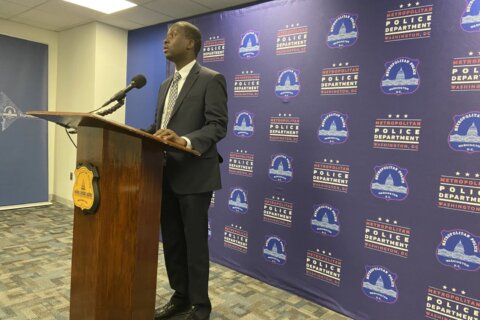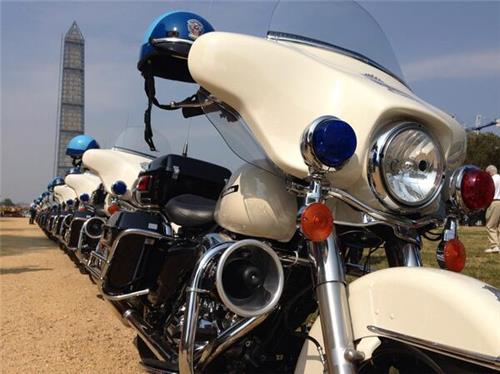Former U.S. Capitol Police Chief Terrance Gainer said he would expect to be fired, if he were still in charge Wednesday, when rioters broke windows, breached security and traipsed through “the people’s house” during a rally in support of outgoing President Donald Trump.
“Watching it, I was sickened,” Gainer told WTOP. “It was nearly heartbreaking to see them in the building, and do what they did in the chambers, and the members’ offices — it was equally disheartening to see our Capitol Police officers fighting hand-to-hand and having weapons out.”
A young woman, who had entered the building as Trump supporters forced their way in the building through doors and broken windows, was shot by a Capitol police officer. The woman died at the hospital.
Despite President Donald Trump inviting supporters to Washington, to challenge the congressional counting of Electoral College votes in President-elect Joe Biden’s victory, Gainer said Capitol Police were clearly overwhelmed when protesters began trying to get past barricades.
“There will be a lot of questions that need answering,” said Gainer, who served as U.S. Capitol Chief of Police from 2002 through 2006, during President George W. Bush’s administration, and as U.S. Senate Sergeant at Arms, from 2007 to 2014. “When we lost the steps, and then lost the upper deck on the east and west side, that was whopping trouble — that’s not supposed to happen.”
Gainer said it was likely people will be fired in the wake of the siege.
“The people in charge of security are the two Sergeant at Arms, and the Chief of Police,” said Gainer. “Ultimately, if it were me, I would expect you and others to be saying why is Gainer still where he’s at — that’s just the responsibility of command.”
Steven Sund, the current Chief of Police was sworn-in, in June 2019.
“I hired him. He was my chief of staff at MPD. These are good people. They’ll want to figure out what happened, and why it happened,” Gainer said.
However, Gainer said he expects political leaders will demand accountability from Congress’s highest-ranking law enforcement official.
“That buck is going to stop on someone’s desk,” said Gainer. “And, you know on the Hill, there’ll be a lot of members who want to throw somebody under the bus.”
Gainer’s leadership experience in crowd control in the nation’s capital stretched back before his tenure as Assistant Chief of the Metropolitan Police Department during the 2000 protests of International Monetary Fund and World Bank.
Asked why Capitol police didn’t take more decisive action, as rioters emptied fire extinguishers in hallways, entered members’ offices, and posed for pictures in the chambers, Gainer wasn’t sure.
“That’s a troubling question. It strikes me that what officers were trying to do is take the welcoming approach that goes on, up on the Hill,” said Gainer. “You want protesters up there, you like the noise, because it’s part of the vitality, the intermixing with the members.”
However, Gainer said once protesters had passed barricades and were on the Capitol steps, officers were unable to keep rioters out of the building.
“When you’re in a situation, where you’re fighting up on that platform, you can start throwing people off and pushing people down the steps, or decide as long as they’re not in the Capitol, we can put up with that. But that left too many spaces vulnerable, being that close to doors and windows.”
“But, they’re not supposed to get as far as they did. And someone needs to explain why that happened,” Gainer said.
In the midst of nationwide calls for police reform, Gainer was asked whether police would have responded more aggressively if those scaling walls, breaking windows and doors, and stealing from elected officials’ offices hadn’t been almost entirely white: “It’s a fair question to raise. I know these people. I don’t believe that was the issue. There was another failure. The officers got overrun.”
However, given the scrutiny of police response in the nation’s capital, Gainer is at a loss to explain the law enforcement failure to protect the Capitol, during the highly-charged last days of the Trump presidency, as he and his supporters desperately look for ways for him to remain in office.
“There’s a lot of police officers up there. There’s a lot of technology. There’s a lot of intel to be had. There’s great collaboration with the Metropolitan Police Department of Washington, and the Secret Service, and the FBI,” Gainer said. He paused for emphasis between each word: “This. Shouldn’t. Have. Got. This. Far.”
Gainer expects it won’t just be law enforcement leadership that will have to answer for the first time since the British set fire to the Capitol, in 1814, that a mob had taken over the seat of American politics and freedom.
“There will be a reckoning,” Gainer said, beyond the 52 people who had been arrested Wednesday, mostly for curfew violations. “There are lots of photographs,” on security cameras within the Capitol.
“And then some of these idiots have gone on television interviews, explaining where they broke into the building,” Gainer said. “They have great pictures of those.”








